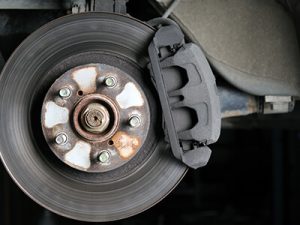In drag racing, a transbrake is a mechanism that selectively places the transmission in first and reverse gears simultaneously, effectively holding the race car stationary as if the foot brake was applied. It is specifically used on automatic transmissions that employ a torque converter, where it is beneficial to build up hydraulic pressure before the vehicle is launched. The transbrake is activated by the driver by applying electric current to a solenoid at the transmission. With the transbrake engaged (transmission locked), the enginethrottle can be increased to any position (opening) in preparation for launch without the race driver worrying about the car creeping forward. Milliseconds before the green light illuminates on the Tree the transbrake is released (by the driver releasing an electrical switch or by a delay box 'timing out' originally triggered by the driver releasing an electrical switch) and the car launches forward, its engine already in the higher power band and the transmission already in low gear.
Brake And Transmission New Zealand
Brake I friction I hydraulic solutions. Carlisle Brake & Friction is a leading global solutions provider of high performance and severe duty brake, clutch and transmission applications for a diverse range of markets. The transbrake is activated by the driver by applying electric current to a solenoid at the transmission. With the transbrake engaged (transmission locked), the engine throttle can be increased to any position (opening) in preparation for launch without the race driver worrying about the car creeping forward.
References[edit]
LET'S SHIFT GEARS FOR A MINUTE..
Transmission is a word that gets thrown around a lot when talking about cars, and rightfully so. This sizable automotive part works hard to keep your vehicle running. A well-operating transmission results in better fuel economy, a smoother ride, and gives you a much better chance at avoiding costly car repairs down the road.

How Does A Transmission Work?
In simple terms, a car's transmission is comparable to a bike's gear shifter. As you speed up on a bike, you switch to a higher gear so your feet don't have to pedal as fast as the wheels spin. Your car's transmission switches the gears in your engine as you speed up or slow down, making sure the correct amount of power is distributed to your wheels.
As you speed up, the transmission works together with the clutch to disengage from the current gear it's in and switch to a higher gear. This ensures the engine doesn't spin too quickly while your wheels are zipping along. As you slow down, the transmission switches your engine back down to lower gears.
Signs You Need Transmission Service:
Grinding noise – If you hear the sound of metal grinding on metal when your car shifts gears, this is a hint you're low on transmission fluid.
Delayed or rushed shifting – You may have issues with your transmission fluid when your vehicle seems to shift gears too early or too late.
Erratic gear shifting – If your car unexpectedly pops in and out of gear, or the engine revs high in between gear shifts, this indicates a faulty transmission.
Smell that? Yikes! – If you notice a burning odor, you could be smelling overheated transmission fluid.
Transmission fluid leak – If you find a puddle of fluid under your car that appears red or brown, you may be looking at transmission fluid.
Brake And Transmission
What Is A Transmission Fluid Flush?
A transmission contains many moving parts that are constantly coming into contact with each other. Transmissions depend on fluid to keep all those parts cool and lubricated.
Factors such as excessive heat and cracked fluid lines can cause the transmission fluid to leak or become contaminated, which can result in serious issues and expensive repairs. A transmission fluid flush involves replacing the old transmission fluid with fresh fluid, providing the gears with proper lubrication and protecting your transmission from debris.
Transmission Parking Brake Assembly

How Often Do You Need A Transmission Fluid Flush?

Download google drive mac os x. How often you should change your transmission fluid depends on mileage and manufacturer recommendations, but luckily, you don't have to replace transmission fluid very often. Most vehicles should have their transmission fluid changed every 30,000 – 60,000 miles.
No matter your mileage, if you begin experiencing any of the symptoms above, come by your nearest Brakes Plus as soon as possible to have your transmission checked out.
What's Included In Our Transmission Flush Service?
Whether you have a manual or automatic transmission, you can trust our expert technicians with your transmission needs. We'll start by removing contaminated fluid from the transmission system using the industry's best flush and exchange equipment. In our service, we also include:
Replacement of up to 15 quarts of synthetic transmission fluid
Smoothing out problems with rough or hard shifting
Filter replacement, if needed, for additional cost
What Is A Trans Brake
When it's time for a transmission flush or inspection, there's no place better than Brakes Plus. Schedule your service online at a time that's convenient for you, and don't forget to check out our offers on transmission service!
